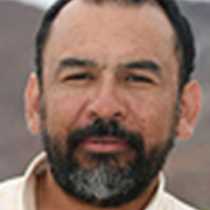Boca de la Soledad, Magdalena Bay
After a very pleasant night’s sleep in the calm waters of Magdalena Lagoon, everyone aboard the National Geographic Sea Bird woke up this morning amazed by the impressive cotton-like clouds, a stationary nearby storm on the Magdalena Plains, and a beautiful red and orange-colored sunrise. The sunlight filtered up through the storm at the starboard side of the ship, and painted the still sand dunes of the barrier island on the portside, giving them different golden tints. At the same time a bright and big silvery moon (with the image of a rabbit stamped on it) hung from a somber blue sky above the mangroves next to the sand dunes. This quietness was broken frequently by the presence of multiple cow and calf pairs of gray whales, and single, possibly mating individuals, all of them slowly moving and skimming the mirror-like surface of the sea with their backs and fins.
Blows here, there and everywhere and literally surrounding our ship, were seen illuminated by ochre back-light, with a sound like a synchronized, antediluvian, magical weird melody. The baby leviathans were always next to their protective mothers but were extremely playful, some lying on the cows’ backs in ecstasies of joy and naiveté. Some single whales lay on their sides, showing flukes and pectoral fins. The mother leviathans, more circumspect, just spy-hopped or positioned themselves belly-up, allowing their calves to tuck on their laps for seconds.
Back to the ground, we had breakfast and got ready for whale watching on Zodiac boats accompanied by our local guides or Zodiac pilots. We explored the beach and sand dunes again, finding numerous interesting things like dolphin skulls, broken carapaces of crabs and sea turtles, coyote tracks, and jackrabbits running away from us. Our graceful wellness specialist, Susan Moebus, found a very intriguing bone that, after a deep analysis by our naturalists, was assigned as a neonatal elephant seal lower jaw.
During the whale-watching rounds of the afternoon we found several approachable pairs of cows and calves, so we had the opportunity of observing all kinds of these leviathans’ behavior: logging and sleeping, breeching, nursing, spy-hopping, rolling, playing, and a long etcetera. A whole and quiet day was spent with these giants, allowing us to enter into their intimate lives in the very heart of their nursery: a coastal lagoon, part of an important wetland system which is also home to the white pelicans, gulls, cormorants, shearwaters and many other birds observed today.




